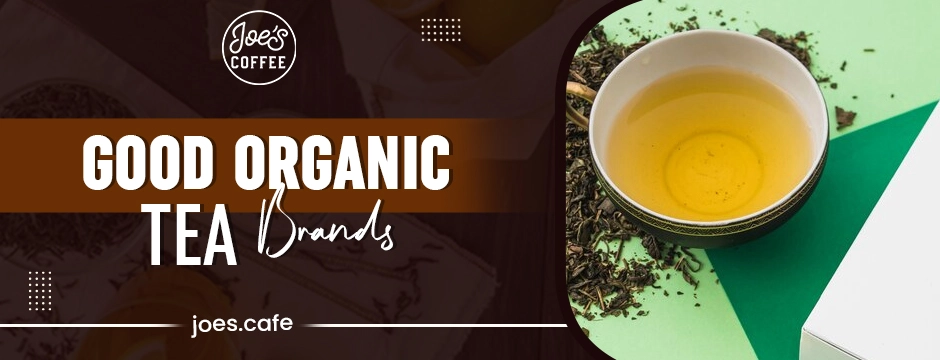
The Art of Tea Tasting: Developing Your Palate and Appreciation for Tea
Tea tasting is a sensory journey that allows individuals to explore the diverse flavours, aromas, and textures of different tea varieties. At Joe’s Cafe, we believe in the importance of cultivating a palate for tea to fully appreciate its nuances and complexities. Developing a palate for tea enhances one’s ability to discern quality, identify flavour profiles, and select teas that align with personal preferences. Good organic tea brands, available at Joe’s Cafe, offer a wide range of options to explore and enjoy.
This blog will guide you through the art of tea tasting, providing techniques for evaluating appearance, aroma, flavour, and mouthfeel. We’ll also offer tips for selecting and brewing the perfect cup of tea using good organic tea brands from Joe’s Cafe.
Understanding Tea Tasting
Tea tasting is a sensory exploration that invites individuals to immerse themselves in the intricate world of tea flavours, aromas, and textures. By engaging the five senses – sight, smell, taste, touch, and even sound – tea enthusiasts can unlock the nuances and complexities of each cup. In this section, we’ll delve into the art of tea tasting, offering insights into how to evaluate appearance, aroma, flavour, and mouthfeel, as well as tips for developing a discerning palate. Join us as we embark on a journey of sensory discovery, guided by the rich diversity of good organic tea brands available at Joe’s Cafe.
The Five Senses: Utilising Sight, Smell, Taste, Touch, and Sound
Tea tasting is a holistic experience that engages all five senses, allowing tea enthusiasts to fully appreciate the intricacies of each cup. From the visual allure of steeped tea to the fragrant aroma that wafts from the cup, every aspect contributes to the overall enjoyment of the tea-drinking experience. Let’s explore how each sense plays a role in tea tasting:
Evaluating Appearance: Colour, Clarity, and Leaf Characteristics
Sight is the first sense engaged in tea tasting, as individuals observe the colour, clarity, and leaf characteristics of the brewed tea. Good organic tea brands, available at Joe’s Cafe, exhibit vibrant hues, clear liquor, and well-formed leaves, indicating freshness and quality.
Exploring Aroma: Fragrance and Complexity
Aroma plays a pivotal role in tea tasting, with the fragrance of steeped tea offering insights into its flavour profile and complexity. Good organic tea brands boast a diverse range of aromas, from floral and fruity to earthy and spicy, enticing the senses with their captivating scents.
Assessing Flavour: Taste Profiles and Nuances
Taste is perhaps the most crucial aspect of tea tasting, as it involves discerning the various flavour profiles and nuances present in the brewed tea. From sweetness and bitterness to astringency and umami, good organic tea brands offer a symphony of tastes that tantalise the palate and leave a lasting impression.
Sensing Mouthfeel: Texture, Body, and Aftertaste
Mouthfeel refers to the tactile sensations experienced while drinking tea, including its texture, body, and aftertaste. Good organic tea brands deliver a satisfying mouthfeel, with teas that are smooth, velvety, and well-balanced, leaving a lingering impression of comfort and satisfaction.
Listening to the Tea: Understanding Sound in Tea Tasting
While less commonly discussed, sound can also provide valuable insights into tea quality. The sound of tea leaves rustling as they steep and water boiling in the kettle can indicate freshness and proper preparation, adding an auditory dimension to the tea-tasting experience.
Developing Sensory Awareness and Sensitivity
To truly appreciate the art of tea tasting, it’s essential to develop sensory awareness and sensitivity. By honing your ability to engage with each sense and expanding your palate through practice and exploration, you can unlock the full potential of the tea-drinking experience. Here’s how to cultivate a deeper connection with tea:
1. Engaging with Each Sense: Mindful Observation and Reflection
Take a moment to engage with each sense mindfully, starting with sight as you observe the colour, clarity, and leaf characteristics of the brewed tea. Then, inhale deeply to savour the fragrance and complexity of the tea’s aroma. Next, take a sip and allow the flavours to dance on your palate, noting any taste profiles and nuances that emerge. Pay attention to the texture, body, and aftertaste of the tea, savouring each sip with intention and reflection.
2. Training Your Palate: Practice and Patience
Like any skill, developing a palate for tea requires practice and patience. Set aside dedicated time for tea tasting sessions, experimenting with different tea varieties, brewing methods, and steeping parameters. Start with teas from good organic tea brands, available at Joe’s Cafe, and gradually expand your repertoire as you become more confident in your tasting abilities. With consistent practice and an open mind, you’ll gradually refine your palate and deepen your appreciation for tea.
3. Exploring Tea Diversity: Sampling a Variety of Teas
Embrace tea diversity by sampling a wide range of teas from different regions, cultivars, and processing methods. Whether you’re drawn to green, black, oolong, white, or pu-erh tea, each variety offers a unique flavour profile and sensory experience. At Joe’s Cafe, we offer a selection of good organic tea brands, allowing you to explore the rich tapestry of tea flavours and discover new favourites. Be adventurous in your tea exploration, and let your curiosity guide you as you embark on a journey of discovery and delight.

Techniques for Tea Tasting
The Tea Tasting Process: Step-by-Step Guide
1. Preparation: Choosing Quality Tea and Proper Brewing Methods
Begin by selecting high-quality tea from good organic tea brands, ensuring freshness and authenticity. Use filtered or spring water heated to the appropriate temperature for the type of tea you’re brewing. Follow proper brewing methods, such as steeping times and water-to-tea ratios, to maximise flavour extraction and enjoyment.
2. Observation: Examining the Tea Leaves and Liquor
Take a moment to visually inspect the tea leaves and liquor. Observe the colour, size, and shape of the dry leaves, noting any variances or irregularities. Then, examine the brewed tea’s colour, clarity, and viscosity, which can provide insights into its quality and flavour profile.
3. Aromatherapy: Inhaling the Fragrance of Steeped Tea
Engage your sense of smell by inhaling the fragrance of the steeped tea. Bring the tea cup close to your nose and take a deep breath, savouring the aroma that emanates from the tea. Note any floral, fruity, earthy, or herbal notes, as well as any complexities or subtleties in the fragrance.
4. Sipping: Tasting Tea with Intention and Focus
Take a small sip of the tea, allowing it to coat your palate and fully engage your taste buds. Pay attention to the initial flavours that greet your tongue, as well as any evolving tastes or sensations that develop as you continue to sip. Consider the tea’s balance, complexity, and intensity, and how it interacts with your senses.
5. Reflection: Noting Impressions and Evaluating the Experience
After tasting the tea, take a moment to reflect on your impressions and evaluate the overall experience. Consider factors such as flavour, aroma, mouthfeel, and aftertaste, as well as any personal preferences or associations that arise. Use a tea tasting notebook or scorecard to record your observations and track your tasting journey.
Common Tea Tasting Tools and Equipment
1. Tea Tasting Sets: Gaiwans, Gongfu Teapots, and Tasting Cups
Invest in quality tea tasting sets, such as gaiwans, gongfu teapots, and tasting cups, which are designed to enhance the tea tasting experience by allowing for precise brewing and serving.
2. Tea Ware: Teapots, Gaiwans, and Tea Strainers
Utilise traditional tea ware, such as teapots, gaiwans, and tea strainers, to brew and serve tea with elegance and efficiency.
3. Tea Tasting Notebooks and Scorecards: Recording Observations
Keep a tea tasting notebook or scorecard to record your observations, including details about the tea’s appearance, aroma, flavour, and overall impression. This allows you to track your tasting experiences and identify patterns or preferences over time.
4. Water and Temperature Control: Importance of Quality Water and Proper Brewing Parameters
Pay attention to water quality and temperature control when brewing tea, as these factors can significantly impact the taste and aroma of the final brew. Use filtered or spring water and adhere to recommended brewing parameters to ensure optimal tea enjoyment.
Tips for Tea Selection and Brewing
Choosing Quality Tea: Sourcing and Selecting Premium Teas
1. Understanding Tea Grades and Quality Indicators
Familiarise yourself with tea grades and quality indicators to make informed decisions when selecting tea. Look for indications of freshness, such as whole tea leaves, buds, or high leaf-to-bud ratios, which are often found in good organic tea brands available at Joe’s Cafe. Pay attention to grading systems specific to certain tea types, such as the grading of green tea in terms of leaf shape, size, and colour.
2. Exploring Different Tea Varieties: Green, Black, Oolong, White, and Pu-erh
Embrace the diversity of tea varieties and explore different types, including green, black, oolong, white, and pu-erh teas. Each type offers unique flavour profiles, processing methods, and health benefits. Experiment with teas from good organic tea brands to discover your preferences and expand your tea palate.
Proper Brewing Techniques: Maximising Tea Flavour and Aroma
1. Water Temperature: Matching Temperature to Tea Type
Pay attention to water temperature when brewing tea, as it can affect the extraction of flavour and aroma. Use lower temperatures for delicate teas such as green and white teas, and higher temperatures for robust teas such as black and pu-erh teas. Good organic tea brands often provide recommendations for water temperature on their packaging or websites.
2. Brewing Time: Steeping Tea for Optimal Flavour Extraction
Adjust brewing time according to the type of tea and personal preference. Shorter steeping times are suitable for delicate teas, while longer steeping times are ideal for stronger teas. Experiment with different brewing times to find the perfect balance of flavour and strength, keeping in mind that over-steeping can result in bitterness.
3. Tea-to-Water Ratio: Finding the Right Balance for Strength and Complexity
Maintain the proper tea-to-water ratio to achieve the desired strength and complexity of flavour. Use approximately 1 teaspoon of tea leaves per 8 ounces of water as a general guideline, but adjust according to taste preferences and tea type. Good organic tea brands often provide recommendations for the ideal tea-to-water ratio.
4. Post-Brewing Considerations: Filtering, Decanting, and Serving
After brewing, consider filtering the tea to remove any leaves or sediment for a smoother drinking experience. Decant the tea into a separate vessel to prevent over-brewing and preserve its flavour. Serve the tea in appropriate teaware, such as teapots or cups, and enjoy the delightful aromas and flavours of your carefully brewed cup of tea.
The Art of Tea Tasting in Practice
Hosting Tea Tasting Events and Workshops
1. Planning and Organising: Choosing Themes and Selecting Teas
Hosting a successful tea tasting event or workshop begins with careful planning and organisation. Consider selecting themes that align with the interests and preferences of participants, such as exploring teas from specific regions or focusing on a particular type of tea. Choose a variety of teas from good organic tea brands available at Joe’s Cafe, assuring a diverse selection that caters to different tastes and preferences.
2. Engaging Participants: Guiding Through the Tea Tasting Process
As the host, guide participants through the tea tasting process with enthusiasm and expertise. Provide background information about each tea, including its origin, processing method, and flavour profile. Encourage participants to engage all their senses as they observe, smell, taste, and reflect on each tea. Offer guidance on proper brewing techniques and encourage participants to ask questions and share their thoughts and experiences.
3. Facilitating Discussion: Encouraging Sharing and Exploration
Foster an atmosphere of open communication and exploration by facilitating discussion among participants. Encourage sharing of tasting notes, impressions, and preferences, allowing everyone to learn from each other’s experiences. Create opportunities for participants to express their curiosity and enthusiasm for tea, fostering a sense of community and connection.
Incorporating Tea Tasting into Daily Rituals
1. Creating Personal Tea Tasting Moments: Morning, Afternoon, and Evening
Integrate tea tasting into daily rituals by setting aside dedicated moments for mindful tea enjoyment. Start your day with a rejuvenating cup of tea in the morning, explore new teas during the afternoon break, and wind down with a relaxing brew in the evening. Use these moments to engage your senses and savour the unique flavours and aromas of each tea, enhancing your overall well-being and appreciation for tea.
2. Pairing Tea with Food: Enhancing Culinary Experiences
Elevate your culinary experiences by pairing tea with food, exploring the intricate interplay of flavours and textures. Experiment with different tea and food combinations, such as pairing light and delicate teas with fresh salads or robust and full-bodied teas with hearty dishes. Consider hosting tea and food pairing events at Joe’s Cafe, where participants can discover new taste sensations and culinary inspirations.
3. Sharing Tea Tasting Experiences: Building Community and Connection
Share your tea tasting experiences with others to build community and connection around a shared passion for tea. Invite friends, family, or colleagues to join you for tea tasting sessions or host tea-themed gatherings where everyone can contribute their favourite teas and share stories and memories. Through shared experiences and conversations, foster a sense of belonging and camaraderie among tea enthusiasts at Joe’s Cafe and beyond.
Conclusion
Tea tasting is not merely a sensory experience but a journey of exploration and discovery, where each cup unveils a world of flavours, aromas, and textures waiting to be explored. By engaging all the senses and embracing the diversity and complexity of tea, we awaken our palates to new sensations and deepen our appreciation for this ancient beverage. Throughout our tea tasting journey, we’ve encountered a rich tapestry of teas, each with its own unique characteristics and stories to tell. From delicate green teas to bold black teas, and from fragrant oolongs to earthy pu-erhs, the diversity of tea reflects the beauty and complexity of the natural world. Let us celebrate this diversity and continue to explore the boundless possibilities that tea has to offer.
As we conclude our exploration of the art of tea tasting, I extend a heartfelt invitation to embark on your own tea tasting adventure with confidence and curiosity. Whether you’re a seasoned tea enthusiast or new to the world of tea, there is always more to discover and enjoy. Visit Joe’s Cafe, where you’ll find a curated selection of good organic tea brands, ready to accompany you on your tea tasting journey. Let your senses guide you as you savour each cup and unlock the secrets of tea’s timeless allure. Cheers to many more tea-filled moments of joy, discovery, and connection.




